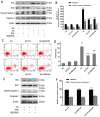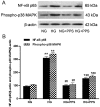Pentosan polysulfate ameliorates apoptosis and inflammation by suppressing activation of the p38 MAPK pathway in high glucose‑treated HK‑2 cells
- PMID: 29207166
- PMCID: PMC5752165
- DOI: 10.3892/ijmm.2017.3290
Pentosan polysulfate ameliorates apoptosis and inflammation by suppressing activation of the p38 MAPK pathway in high glucose‑treated HK‑2 cells
Abstract
The apoptosis of tubular epithelial cells in diabetic nephropathy (DN) is commonly observed in human renal biopsies. Inflammation plays a key role in DN, and pentosan polysulfate (PPS) has been shown to largely attenuate the inflammation of nephropathy in aging diabetic mice. p38 mitogen‑activated protein kinase (p38 MAPK) plays a crucial role in tissue inflammation and cell apoptosis, and it is activated by hyperglycemia. In the present study, high glucose (HG)‑treated human renal proximal tubular epithelial cells (HK‑2) were used to examine the protective effects of PPS against HG‑stimulated apoptosis and inflammation. The results of the study revealed that PPS markedly suppressed the HG‑induced reduction in cell viability. Incubation of HK‑2 cells with HG activated the p38 MAPK pathway and, subsequently, as confirmed by western blot analysis and flow cytometry, increased cell apoptosis, which was blocked by PPS. In addition, PPS treatment significantly inhibited HG‑stimulated p38 MAPK and nuclear factor‑κB activation, and reduced the production of pro‑inflammatory cytokines, such as tumor necrosis factor‑α, interleukin (IL)‑1β and IL‑6. In conclusion, PPS ameliorates p38 MAPK‑mediated renal cell apoptosis and inflammation. The anti‑apoptotic actions and anti‑inflammatory effects of PPS prompt further investigation of this compound as a promising therapeutic agent against DN.
Figures






Similar articles
-
Inhibition of inflammation by pentosan polysulfate impedes the development and progression of severe diabetic nephropathy in aging C57B6 mice.Lab Invest. 2011 Oct;91(10):1459-71. doi: 10.1038/labinvest.2011.93. Epub 2011 Aug 1. Lab Invest. 2011. PMID: 21808238
-
Gallic acid ameliorates renal functions by inhibiting the activation of p38 MAPK in experimentally induced type 2 diabetic rats and cultured rat proximal tubular epithelial cells.Chem Biol Interact. 2015 Oct 5;240:292-303. doi: 10.1016/j.cbi.2015.08.026. Epub 2015 Sep 1. Chem Biol Interact. 2015. PMID: 26341651
-
Protein extracted from Porphyra yezoensis prevents cisplatin-induced nephrotoxicity by downregulating the MAPK and NF-κB pathways.Int J Mol Med. 2018 Jan;41(1):511-520. doi: 10.3892/ijmm.2017.3214. Epub 2017 Oct 26. Int J Mol Med. 2018. PMID: 29115386
-
The pathogenic role of the renal proximal tubular cell in diabetic nephropathy.Nephrol Dial Transplant. 2012 Aug;27(8):3049-56. doi: 10.1093/ndt/gfs260. Epub 2012 Jun 25. Nephrol Dial Transplant. 2012. PMID: 22734110 Review.
-
Renal tubular cell death and inflammation response are regulated by the MAPK-ERK-CREB signaling pathway under hypoxia-reoxygenation injury.J Recept Signal Transduct Res. 2019 Oct-Dec;39(5-6):383-391. doi: 10.1080/10799893.2019.1698050. Epub 2019 Nov 29. J Recept Signal Transduct Res. 2019. PMID: 31782334 Review.
Cited by
-
Pathomechanisms of Diabetic Kidney Disease.J Clin Med. 2023 Nov 27;12(23):7349. doi: 10.3390/jcm12237349. J Clin Med. 2023. PMID: 38068400 Free PMC article. Review.
-
Pentosan Polysulfate Affords Pleotropic Protection to Multiple Cells and Tissues.Pharmaceuticals (Basel). 2023 Mar 13;16(3):437. doi: 10.3390/ph16030437. Pharmaceuticals (Basel). 2023. PMID: 36986536 Free PMC article. Review.
-
Spleen tyrosine kinase promotes NLR family pyrin domain containing 3 inflammasome‑mediated IL‑1β secretion via c‑Jun N‑terminal kinase activation and cell apoptosis during diabetic nephropathy.Mol Med Rep. 2018 Aug;18(2):1995-2008. doi: 10.3892/mmr.2018.9164. Epub 2018 Jun 14. Mol Med Rep. 2018. PMID: 29901140 Free PMC article.
-
Dual specificity phosphatase 22 suppresses mesangial cell hyperproliferation, fibrosis, inflammation and the MAPK signaling pathway in diabetic nephropathy.Exp Ther Med. 2022 Nov 7;24(6):744. doi: 10.3892/etm.2022.11680. eCollection 2022 Dec. Exp Ther Med. 2022. PMID: 36561966 Free PMC article.
-
Exogenous sodium hydrosulfide protects against high glucose‑induced injury and inflammation in human umbilical vein endothelial cells by inhibiting necroptosis via the p38 MAPK signaling pathway.Mol Med Rep. 2021 Jan;23(1):67. doi: 10.3892/mmr.2020.11706. Epub 2020 Nov 20. Mol Med Rep. 2021. PMID: 33215220 Free PMC article.
References
MeSH terms
Substances
LinkOut - more resources
Full Text Sources
Other Literature Sources
Medical

